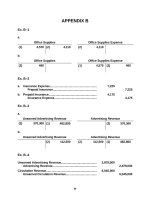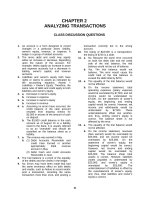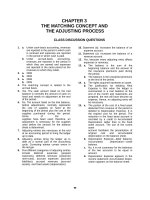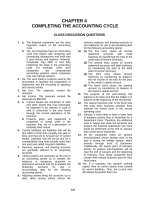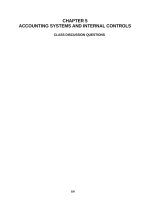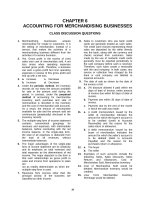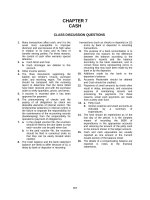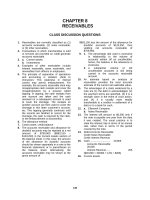Solution manual microeconomics 7e by pindyck ch5
Bạn đang xem bản rút gọn của tài liệu. Xem và tải ngay bản đầy đủ của tài liệu tại đây (236.42 KB, 12 trang )
To download more slides, ebook, solutions and test bank, visit
Chapter 5: Uncertainty and Consumer Behavior
CHAPTER 5
UNCERTAINTY AND CONSUMER BEHAVIOR
TEACHING NOTES
This is a useful chapter for business-oriented courses, particularly if you intend to cover the
role of risk in capital markets in Chapter 15. It is also good background for Chapter 17 on asymmetric
information. On the other hand, you will not able to cover everything in the book, so if there are other
topics you wish to cover instead, you may skip this chapter without disrupting the overall flow of the
text.
You might start by asking students how uncertainty affects the decisions made by consumers
and firms. Consumers may not know their incomes for sure, they are uncertain about the quality of
some of the goods they buy (so it is difficult to know the utility they will receive from purchasing those
goods); business firms are uncertain about the demands for their products, the future costs of inputs,
and the exchange rate for foreign currencies; investors don’t know whether their investments will
increase or decrease in value; etc. Then ask how people deal with these risks. For example, there are
many types of insurance including auto, life and unemployment, companies offer product warranties
and refunds, farmers and other firms can hedge against price uncertainty in futures markets,
businesses can hedge foreign exchange risks in forward markets, and investors can diversity.
If students have not previously been exposed to probability, expected value, and variance, the
basics are covered in Section 5.1. However, this is a fast run-through even for those who have had a
basic statistics course, so you may find Exercises 1 through 5 useful as they provide practice calculating
expected value and variance. Many students think of risk as arising from the possibility of loss or
injury; they do not consider that risk can also be due to uncertain gains. It is easy to construct simple
examples where there are only gains to make the point that risk still exists. For example, with
alternative 1 you get nothing if a coin comes up heads and $1000 if it comes up tails. With alternative
2, you get $300 for sure. Alternative 1 is clearly more risky. You can mention that variance (or
standard deviation), which is often used as a measure of riskiness, takes into account both gains and
losses.
Preferences toward risk depend on the decision maker’s von Neumann-Morgenstern utility
function, which is different from the utility functions in Chapters 3 and 4. Utility in this chapter has
some cardinal properties and depends on the monetary payoff to the decision maker, whereas utility in
earlier chapters was ordinal and depended on the amount of various goods consumed. To emphasize
this difference, utility is denoted by a lower case u in this chapter.
There are a number of issues that trip up students in Chapter 5. Most importantly, students
often confuse expected utility and the utility of the expected value. Give them a couple of examples to
make sure they understand the difference.
For instance, if u( x ) = x , the expected utility for
alternative 1 in the example above is Eu = 0.5u(0) + 0.5u(1000) = 0.5 0 + 0.5 1000 = 15.81 . On the other
hand, the expected value for alternative 1 is E ( x ) = 0.5(0) + 0.5(1000) = 500 , and the utility of the
expected value is therefore u[ E ( x )] = 500 = 22.36 , which is quite different from the expected utility.
Students also have difficulty understanding Figure 5.4 that illustrates the risk premium. They
do not understand why the point on the chord (point F) represents expected utility. You will need to
explain this carefully. You should also make sure students understand that even risk averse people
take risks. Being risk averse does not mean avoiding all risks. Everyone takes risks when the possible
rewards are greater than the costs. For instance, most people have parked illegally when they are in a
hurry (or late for an exam). We all drive cars, risking accidents and injury, and many people buy
stocks and bonds even though those investments may decrease in value. In fact, there really is no way
to live and avoid all risks.
76
Copyright © 2009 Pearson Education, Inc. Publishing as Prentice Hall.
To download more slides, ebook, solutions and test bank, visit
Chapter 5: Uncertainty and Consumer Behavior
Even if your students have not fully understood the technical aspects of choice under
uncertainty, they should easily comprehend Examples 5.1 and 5.2 (the latter example leads to Exercise
8).
This is also true of the topics presented in Section 5.3, diversification, insurance and value of
information, and Examples 5.3 and 5.4. Also, you might mention the problems of adverse selection and
moral hazard in insurance, to be discussed in Chapter 17.
Section 5.4 is more difficult and may be skipped or postponed until after the class has
completed the discussion of risk and rates of return in Chapter 15. The last section is a brief
introduction to behavioral economics. Most students find this section quite interesting because it
considers situations in which people do not behave as rationally as economists typically assume they
do.
QUESTIONS FOR REVIEW
1. What does it mean to say that a person is risk averse? Why are some people likely to be
risk averse while others are risk lovers?
A risk averse person has a diminishing marginal utility of income and prefers a certain
income to a gamble with the same expected income. A risk lover has an increasing
marginal utility of income and prefers an uncertain income to a certain income when
the expected value of the uncertain income equals the certain income. To some extent,
a person’s risk preferences are like preferences for different vegetables. They may be
inborn or learned from parents or others, and we cannot easily say why some people
are risk averse while others like taking risks. But there are some economic factors that
can affect risk preferences. For example, a wealthy person is more likely to take risks
than a moderately well off person, because the wealthy person can better handle losses.
Also, people are more likely to take risks when the stakes are low (like office pools
around NCAA basketball time) than when stakes are high (like losing a house to fire).
2. Why is the variance a better measure of variability than the range?
Range is the difference between the highest possible outcome and the lowest possible
outcome. Range ignores all outcomes except the highest and lowest, and it does not
consider how likely each outcome is. Variance, on the other hand, is based on all the
outcomes and how likely they are to occur. Variance weights the difference of each
outcome from the mean outcome by its probability and, thus, is a more comprehensive
measure of variability than the range.
3. George has $5000 to invest in a mutual fund. The expected return on mutual fund A is
15 percent and the expected return on mutual fund B is 10 percent. Should George pick
mutual fund A or fund B?
George’s decision will depend not only on the expected return for each fund, but also on
the variability of each fund’s returns and on George’s risk preferences. For example, if
fund A has a higher standard deviation than fund B, and George is risk averse, then he
may prefer fund B even though it has a lower expected return. If George is not
particularly risk averse he may choose fund A even if its return is more variable.
4. What does it mean for consumers to maximize expected utility? Can you think of a case
in which a person might not maximize expected utility?
To maximize expected utility means that the individual chooses the option that yields
the highest average utility, where average utility is the probability-weighted sum of all
utilities. This theory requires that the consumer knows each possible outcome that
may occur and the probability of each outcome. Sometimes consumers either do not
know all possible outcomes and the relevant probabilities, or they have difficulty
evaluating low-probability, extreme-payoff events.
77
Copyright © 2009 Pearson Education, Inc. Publishing as Prentice Hall.
To download more slides, ebook, solutions and test bank, visit
Chapter 5: Uncertainty and Consumer Behavior
In some cases, consumers cannot assign a utility level to these extreme-payoff events,
such as when the payoff is the loss of the consumer’s life. In cases like this, consumers
may make choices based on other criteria such as risk avoidance.
5. Why do people often want to insure fully against uncertain situations even when the
premium paid exceeds the expected value of the loss being insured against?
Risk averse people have declining marginal utility, and this means that the pain of a
loss increases at an increasing rate as the size of the loss increases. As a result, they
are willing to pay more than the expected value of the loss to insure against suffering
the loss. For example, suppose a homeowner does not insure his house that is worth
$200,000. Also suppose there is a small .001 probability that the house will burn to the
ground and be a total loss. This means there is a high probability of .999 that there
will be no loss. The expected loss is .001(200,000) + .999(0) = $200. Many risk averse
homeowners would be willing to pay a lot more than $200 (like $400 or $500) to buy
insurance that will replace the house if it burns. They do this because the disutility of
losing their $200,000 house is more than 1000 times larger than the disutility of paying
the insurance premium.
6. Why is an insurance company likely to behave as if it were risk neutral even if its
managers are risk-averse individuals?
A large insurance company sells hundreds of thousands of policies, and the company’s
managers know they will have to pay for losses incurred by some of their policyholders
even though they do not know which particular policies will result in claims. Because
of the law of large numbers, however, the company can estimate the total number of
claims quite accurately. Therefore, it can make very precise estimates of the total
amount it will have to pay in claims. This means the company faces very little risk
overall and consequently behaves essentially as if it were risk neutral. Each manager,
on the other hand, cannot diversify his or her own personal risks to the same extent,
and thus each faces greater risk and behaves in a much more risk averse manner.
7. When is it worth paying to obtain more information to reduce uncertainty?
It is worth paying for information if the information leads the consumer to make
different choices than she would have made without the information, and the expected
utility of the payoffs (deducting the cost of the information) is greater with the
information than the expected utility of the payoffs received when making the best
choices without knowing the information.
8. How does the diversification of an investor’s portfolio avoid risk?
An investor reduces risk by investing in many assets whose returns are not highly
correlated and, even better, some whose returns are negatively correlated. A mutual
fund, for example, is a portfolio of stocks of many different companies. If the rate of
return on each company’s stock is not highly related to the rates of return earned on
the other stocks in the portfolio, the portfolio will have a lower variance than any of the
individual stocks. This occurs because low returns on some stocks tend to be offset by
high returns on others. As the number of stocks in the portfolio increases, the
portfolio’s variance decreases. While there is less risk in a portfolio of stocks, risk
cannot be completely avoided; there is still some market risk in holding a portfolio of
stocks compared to a low-risk asset, such as a U.S. government savings bond.
9. Why do some investors put a large portion of their portfolios into risky asset, while
others invest largely in risk-free alternatives? (Hint: Do the two investors receive exactly
the same return on average? If so, why?)
Most investors are risk averse, but some are more risk averse than others. Investors
who are highly risk averse will invest largely in risk-free alternatives while those who
are less risk averse will put a larger portion of their portfolios into risky assets.
78
Copyright © 2009 Pearson Education, Inc. Publishing as Prentice Hall.
To download more slides, ebook, solutions and test bank, visit
Chapter 5: Uncertainty and Consumer Behavior
Of course, because investors are risk averse, they will demand higher rates of return on
investments that have higher levels of risk (i.e., higher variances). So investors who
put larger amounts into risky assets expect to earn greater rates of return than those
who invest primarily in risk-free assets.
10. What is an endowment effect? Give an example of such an effect.
An endowment effect exists if an individual places a higher value on an item that is in
her possession as compared to the value she places on the same item when it is not in
her possession. For example, some people might refuse to pay $5 for a simple coffee
mug but would also refuse to sell the same mug for $5 if they already owned it or had
just gotten it for free.
11. Jennifer is shopping and sees an attractive shirt. However, the price of $50 is more
than she is willing to pay. A few weeks later, she finds the same shirt on sale for $25 and
buys it. When a friend offers her $50 for the shirt, she refuses to sell it. Explain
Jennifer’s behavior.
To help explain Jennifer’s behavior, we need to look at the reference point from
which she is making the decision. In the first instance, she does not own the shirt so
she is not willing to pay the $50 to buy the shirt. In the second instance, she will not
accept $50 for the shirt from her friend because her reference point has changed.
Once she owns the shirt, the value she attaches to it increases. Individuals often
value goods more when they own them than when they do not. This is called the
endowment effect.
EXERCISES
1. Consider a lottery with three possible outcomes:
•
$125 will be received with probability .2
•
$100 will be received with probability .3
•
$50 will be received with probability .5
a. What is the expected value of the lottery?
The expected value, EV, of the lottery is equal to the sum of the returns weighted by
their probabilities:
EV = (0.2)($125) + (0.3)($100) + (0.5)($50) = $80.
b. What is the variance of the outcomes?
The variance, σ2, is the sum of the squared deviations from the mean, $80, weighted by
their probabilities:
σ2 = (0.2)(125 - 80)2 + (0.3)(100 - 80)2 + (0.5)(50 - 80)2 = $975.
c. What would a risk-neutral person pay to play the lottery?
A risk-neutral person would pay the expected value of the lottery: $80.
79
Copyright © 2009 Pearson Education, Inc. Publishing as Prentice Hall.
To download more slides, ebook, solutions and test bank, visit
Chapter 5: Uncertainty and Consumer Behavior
2. Suppose you have invested in a new computer company whose profitability depends on
two factors: (1) whether the U.S. Congress passes a tariff raising the cost of Japanese
computers and (2) whether the U.S. economy grows slowly or quickly. What are the four
mutually exclusive states of the world that you should be concerned about?
The four mutually exclusive states may be represented as:
Congress passes tariff
Congress does not pass tariff
Slow growth rate
State 1:
Slow growth with tariff
State 2:
Slow growth without tariff
Fast growth rate
State 3:
Fast growth with tariff
State 4:
Fast growth without tariff
3. Richard is deciding whether to buy a state lottery ticket. Each ticket costs $1, and the
probability of winning payoffs is given as follows:
Probability
Return
0.50
$0.00
0.25
$1.00
0.20
$2.00
0.05
$7.50
a. What is the expected value of Richard’s payoff if he buys a lottery ticket? What is
the variance?
The expected value of the lottery is equal to the sum of the returns weighted by their
probabilities:
EV = (0.5)($0) + (0.25)($1.00) + (0.2)($2.00) + (0.05)($7.50) = $1.025
The variance is the sum of the squared deviations from the mean, $1.025, weighted by
their probabilities:
σ2 = (0.5)(0 – 1.025)2 + (0.25)(1 – 1.025)2 + (0.2)(2 – 1.025)2 + (0.05)(7.5 – 1.025)2, or
σ2 = 2.812.
b. Richard’s nickname is “No-Risk Rick” because he is an extremely risk-averse
individual. Would he buy the ticket?
An extremely risk-averse individual would probably not buy the ticket. Even though
the expected value is higher than the price of the ticket, $1.025 > $1.00, the difference
is not enough to compensate Rick for the risk. For example, if his wealth is $10 and he
buys a $1.00 ticket, he would have $9.00, $10.00, $11.00, and $16.50, respectively,
under the four possible outcomes. If his utility function is U = W0.5, where W is his
wealth, then his expected utility is:
EU = (0.5)(90.5 )+ (0.25)(100.5 )+ (0.2 )(110.5 )+ (0.05)(16.50.5 ) = 3.157.
This is less than 3.162, which is his utility if he does not buy the ticket (U(10) = 100.5 =
3.162). Therefore, he would not buy the ticket.
80
Copyright © 2009 Pearson Education, Inc. Publishing as Prentice Hall.
To download more slides, ebook, solutions and test bank, visit
Chapter 5: Uncertainty and Consumer Behavior
c. Richard has been given 1000 lottery tickets. Discuss how you would determine the
smallest amount for which he would be willing to sell all 1000 tickets.
With 1000 tickets, Richard’s expected payoff is $1025. He does not pay for the tickets,
so he cannot lose money, but there is a wide range of possible payoffs he might receive
ranging from $0 (in the extremely unlikely case that all 1000 tickets pay nothing) to
$7500 (in the even more unlikely case that all 1000 tickets pay the top prize of $7.50),
and everything in between. Given this variability and Richard’s high degree of risk
aversion, we know that Richard would be willing to sell all the tickets for less (and
perhaps considerably less) than the expected payoff of $1025. More precisely, he would
sell the tickets for $1025 minus his risk premium. To find his selling price, we would
first have to calculate his expected utility for the lottery winnings. This would be like
point F in Figure 5.4, except that in Richard’s case there are thousands of possible
payoffs, not just two as in the figure. Using his expected utility value, we then would
find the certain amount that gives him the same level of utility. This is like the
$16,000 income at point C in Figure 5.4. That certain amount is the smallest amount
for which he would be willing to sell all 1000 lottery tickets.
d. In the long run, given the price of the lottery tickets and the
probability/return table, what do you think the state would do about the
lottery?
Given the price of the tickets, the sizes of the payoffs and the probabilities, the lottery
is a money loser. The state loses $1.025 – 1.00 = $0.025 (two and a half cents) on every
ticket it sells. The state must raise the price of a ticket, reduce some of the payoffs,
raise the probability of winning nothing, lower the probabilities of the positive payoffs,
or some combination of the above.
4. Suppose an investor is concerned about a business choice in which there are three
prospects – the probability and returns are given below:
Probability
Return
0.4
$100
0.3
30
0.3
–30
What is the expected value of the uncertain investment? What is the variance?
The expected value of the return on this investment is
EV = (0.4)(100) + (0.3)(30) + (0.3)(–30) = $40.
The variance is
σ2 = (0.4)(100 – 40)2 + (0.3)(30 – 40)2 + (0.3)(–30 – 40)2 = 2940.
5. You are an insurance agent who must write a policy for a new client named Sam. His
company, Society for Creative Alternatives to Mayonnaise (SCAM), is working on a low-fat,
low-cholesterol mayonnaise substitute for the sandwich-condiment industry. The sandwich
industry will pay top dollar to the first inventor to patent such a mayonnaise substitute.
Sam’s SCAM seems like a very risky proposition to you. You have calculated his possible
returns table as follows:
Probability
Return
Outcome
.999
–$1,000,000
(he fails)
.001
$1,000,000,000
(he succeeds and sells his formula)
81
Copyright © 2009 Pearson Education, Inc. Publishing as Prentice Hall.
To download more slides, ebook, solutions and test bank, visit
Chapter 5: Uncertainty and Consumer Behavior
a. What is the expected return of Sam’s project? What is the variance?
The expected return, ER, of Sam’s investment is
ER = (0.999)(–1,000,000) + (0.001)(1,000,000,000) = $1000.
The variance is
σ2 = (0.999)(–1,000,000 – 1000)2 + (0.001)(1,000,000,000 – 1000)2 , or
σ2 = 1,000,998,999,000,000.
b. What is the most that Sam is willing to pay for insurance? Assume Sam is risk
neutral.
Suppose the insurance guarantees that Sam will receive the expected return of $1000
with certainty regardless of the outcome of his SCAM project. Because Sam is risk
neutral and because his expected return is the same as the guaranteed return with
insurance, the insurance has no value to Sam. He is just as happy with the uncertain
SCAM profits as with the certain outcome guaranteed by the insurance policy. So Sam
will not pay anything for the insurance.
c. Suppose you found out that the Japanese are on the verge of introducing their own
mayonnaise substitute next month. Sam does not know this and has just turned
down your final offer of $1000 for the insurance. Assume that Sam tells you SCAM is
only six months away from perfecting its mayonnaise substitute and that you know
what you know about the Japanese. Would you raise or lower your policy premium
on any subsequent proposal to Sam? Based on his information, would Sam accept?
The entry of the Japanese lowers Sam’s probability of a high payoff. For example,
assume that the probability of the billion-dollar payoff is lowered to zero. Then the
expected outcome is:
ER = (1.0)(–$1,000,000) + (0.0)(($1,000,000,000) = –$1,000,000.
Therefore, you should raise the policy premium substantially. But Sam, not knowing
about the Japanese entry, will continue to refuse your offers to insure his losses.
6. Suppose that Natasha’s utility function is given by
annual income in thousands of dollars.
u(I) = 10I , where I represents
a. Is Natasha risk loving, risk neutral, or risk averse? Explain.
Natasha is risk averse. To show this, assume that she has $10,000 and is offered a
gamble of a $1000 gain with 50 percent probability and a $1000 loss with 50 percent
probability. Her utility of $10,000 is u(10) =
10(10) = 10. Her expected utility with
the gamble is:
EU = (0.5) 10(11) + (0.5) 10(9) = 9.987 < 10.
She would avoid the gamble. If she were risk neutral, she would be indifferent between
the $10,000 and the gamble, and if she were risk loving, she would prefer the gamble.
You can also see that she is risk averse by noting that the square root function
increases at a decreasing rate (the second derivative is negative), implying diminishing
marginal utility.
82
Copyright © 2009 Pearson Education, Inc. Publishing as Prentice Hall.
To download more slides, ebook, solutions and test bank, visit
Chapter 5: Uncertainty and Consumer Behavior
b. Suppose that Natasha is currently earning an income of $40,000 (I = 40) and can earn
that income next year with certainty. She is offered a chance to take a new job that
offers a .6 probability of earning $44,000 and a .4 probability of earning $33,000.
Should she take the new job?
The utility of her current salary is
10( 40) = 20. The expected utility of the new job’s
salary is
EU = (0.6) 10( 44) + (0.4) 10(33) = 19.85,
which is less than 20. Therefore, she should not take the job. You can also determine
that Natasha should reject the job by noting that the expected value of the new job is
only $39,600, which is less than her current salary. Since she is risk averse, she should
never accept a risky salary with a lower expected value than her current certain salary.
c. In (b), would Natasha be willing to buy insurance to protect against the variable
income associated with the new job? If so, how much would she be willing to pay for
that insurance? (Hint: What is the risk premium?)
This question assumes that Natasha takes the new job (for some unexplained reason).
Her expected salary is 0.6(44,000) + 0.4(33,000) = $39,600. The risk premium is the
amount Natasha would be willing to pay so that she receives the expected salary for
certain rather than the risky salary in her new job. In part (b) we determined that her
new job has an expected utility of 19.85. We need to find the certain salary that gives
Natasha the same utility of 19.85, so we want to find I such that u(I) = 19.85. Using
her utility function, we want to solve the following equation: 10 I = 19.85 . Squaring
both sides, 10I =394.02, and I = 39.402. So Natasha would be equally happy with a
certain salary of $39,402 or the uncertain salary with an expected value of $39,600.
Her risk premium is $39,600 – 39,402 = $198. Natasha would be willing to pay $198 to
guarantee her income would be $39,600 for certain and eliminate the risk associated
with her new job.
7. Suppose that two investments have the same three payoffs, but the probability
associated with each payoff differs, as illustrated in the table below:
Probability
Probability
Payoff
(Investment A)
(Investment
B)
$300
0.10
0.30
$250
0.80
0.40
$200
0.10
0.30
a. Find the expected return and standard deviation of each investment.
The expected value of the return on investment A is
EV = (0.1)(300) + (0.8)(250) + (0.1)(200) = $250.
The variance on investment A is
σ2 = (0.1)(300 - 250)2 + (0.8)(250 - 250)2 + (0.1)(200 - 250)2 = $500,
and the standard deviation on investment A is σ =
83
500 = $22.36.
Copyright © 2009 Pearson Education, Inc. Publishing as Prentice Hall.
To download more slides, ebook, solutions and test bank, visit
Chapter 5: Uncertainty and Consumer Behavior
The expected value of the return on investment B is
EV = (0.3)(300) + (0.4)(250) + (0.3)(200) = $250.
The variance on investment B is
σ2 = (0.3)(300 - 250)2 + (0.4)(250 - 250)2 + (0.3)(200 - 250)2 = $1500,
and the standard deviation on investment B is σ =
1500 = $38.73.
b. Jill has the utility function U = 5I , where I denotes the payoff. Which investment
will she choose?
Jill’s expected utility from investment A is
EU= (0.1)[5(300)] + (0.8)[5(250)] + (0.1)[5(200)] = 1250.
Jill’s expected utility from investment B is
EU=(0.3)[5(300)] + (0.4)[5(250)] + (0.3)[5(200)] = 1250.
Since both investments give Jill the same expected utility she will be indifferent
between the two. Note that Jill is risk neutral, so she cares only about expected
values. Since investments A and B have the same expected values, she is indifferent
between them.
c. Ken has the utility function U = 5 I . Which investment will he choose?
Ken’s expected utility from investment A is
EU = (0.1)(5 300 ) + (0.8)(5 250 ) + (0.1)(5 200 ) = 78.98.
Ken’s expected utility from investment B is
EU=(0.3)(5 300 ) + (0.4)(5 250 ) + (0.3)(5 200 ) = 78.82.
Ken will choose investment A because it has a slightly higher expected utility.
Notice that Ken is risk averse, so he prefers the investment with less variability.
2
d. Laura has the utility function U = 5I . Which investment will she choose?
Laura’s expected utility from investment A is
EU=(0.1)[5(3002)] + (0.8)[5(2502)] + (0.1)[5(2002)] = 315,000.
Laura’s expected utility from investment B is
EU=(0.3)[5(3002)] + (0.4)[5(2502)] + (0.3)[5(2002)] = 320,000.
Laura will choose investment B since it has a higher expected utility. Notice that
Laura is a risk lover, so she prefers the investment with greater variability.
84
Copyright © 2009 Pearson Education, Inc. Publishing as Prentice Hall.
To download more slides, ebook, solutions and test bank, visit
Chapter 5: Uncertainty and Consumer Behavior
8. As the owner of a family farm whose wealth is $250,000, you must choose between
sitting this season out and investing last year’s earnings ($200,000) in a safe money
market fund paying 5.0 percent or planting summer corn. Planting costs $200,000, with a
six-month time to harvest. If there is rain, planting summer corn will yield $500,000 in
revenues at harvest. If there is a drought, planting will yield $50,000 in revenues. As a
third choice, you can purchase AgriCorp drought-resistant summer corn at a cost of
$250,000 that will yield $500,000 in revenues at harvest if there is rain, and $350,000 in
revenues if there is a drought. You are risk averse, and your preference for family wealth
(W) is specified by the relationship U(W ) = W . The probability of a summer drought is
0.30, while the probability of summer rain is 0.70. Which of the three options should you
choose? Explain.
Calculate the expected utility of wealth under the three options. Wealth is equal to
the initial $250,000 plus whatever is earned growing corn or investing in the safe
financial asset. Expected utility under the safe option, allowing for the fact that your
initial wealth is $250,000, is:
E(U) = (250,000 + 200,000(1 + .05)).5 = 678.23.
Expected utility with regular corn, again including your initial wealth, is:
E(U) = .7(250,000 + (500,000 – 200,000)).5 + .3(250,000 + (50,000 – 200,000)).5 =
519.13 + 94.87 = 614.
Expected utility with drought-resistant corn is:
E(U) = .7(250,000 + (500,000 – 250,000)).5 + .3(250,000 + (350,000 – 250,000)).5 =
494.975 + 177.482 = 672.46.
You should choose the option with the highest expected utility, which is the safe
option of not planting corn.
Note: There is a subtle time issue in this problem. The returns from planting corn
occur in 6 months while the money market fund pays 5%, which is presumably a
yearly interest rate. To put everything on equal footing, we should compare the
returns of all three alternatives over a 6-month period. In this case, the money
market fund would earn about 2.5%, so its expected utility is:
E(U) = (250,000 + 200,000(1 + .025)).5 = 674.54.
This is still the best of the three options, but by a smaller margin than before.
9. Draw a utility function over income u(I) that describes a man who is a risk lover when
his income is low but risk averse when his income is high. Can you explain why such a
utility function might reasonably describe a person’s preferences?
The utility function will be S-shaped as illustrated below. Preferences might be like this for
an individual who needs a certain level of income, I*, in order to stay alive. An increase in
income above I* will have diminishing marginal utility. Below I*, the individual will be a
risk lover and will take unfavorable gambles in an effort to make large gains in income. Above
I*, the individual will purchase insurance against losses and below I* will gamble.
85
Copyright © 2009 Pearson Education, Inc. Publishing as Prentice Hall.
To download more slides, ebook, solutions and test bank, visit
Chapter 5: Uncertainty and Consumer Behavior
10. A city is considering how much to spend to hire people to monitor its parking meters.
The following information is available to the city manager:
•
Hiring each meter monitor costs $10,000 per year.
•
With one monitoring person hired, the probability of a driver getting a ticket each
time he or she parks illegally is equal to .25.
•
With two monitors, the probability of getting a ticket is .5; with three monitors, the
probability is .75; and with four, it’s equal to 1.
•
With two monitors hired, the current fine for overtime parking is $20.
a. Assume first that all drivers are risk neutral. What parking fine would you levy, and
how many meter monitors would you hire (1, 2, 3, or 4) to achieve the current level of
deterrence against illegal parking at the minimum cost?
If drivers are risk neutral, their behavior is influenced only by their expected fine.
With two meter monitors, the probability of detection is 0.5 and the fine is $20. So, the
expected fine is (0.5)($20) + (0.5)(0) = $10. To maintain this expected fine, the city can
hire one meter monitor and increase the fine to $40, or hire three meter monitors and
decrease the fine to $13.33, or hire four meter monitors and decrease the fine to $10.
If the only cost to be minimized is the cost of hiring meter monitors at $10,000 per year
you, as the city manager, should minimize the number of meter monitors. Hire only one
monitor and increase the fine to $40 to maintain the current level of deterrence.
b. Now assume that drivers are highly risk averse. How would your answer to (a)
change?
If drivers are risk averse, they would want to avoid the possibility of paying parking
fines even more than would risk neutral drivers. Therefore, a fine of less than $40 with
one meter monitor should maintain the current level of deterrence.
c. (For discussion) What if drivers could insure themselves against the risk of parking
fines? Would it make good public policy to permit such insurance?
Drivers engage in many forms of behavior to insure themselves against the risk of
parking fines, such as checking the time often to be sure they have not parked
overtime, parking blocks away from their destination in non-metered spots or taking
public transportation. If a private insurance firm offered insurance that paid the fine
when a ticket was received, drivers would not worry about getting tickets. They would
not seek out unmetered spots or take public transportation; they would park in
metered spaces for as long as they wanted at zero personal cost. Having the insurance
would lead drivers to get many more parking tickets. This is referred to as moral
hazard and may cause the insurance market to collapse, but that’s another story (see
Section 17.3 in Chapter 17).
It probably would not make good public policy to permit such insurance. Parking is
usually metered to encourage efficient use of scarce parking space. People with
insurance would have no incentive to use public transportation, seek out-of-the-way
parking locations or economize on their use of metered spaces. This imposes a cost on
others who are not able to find a place to park. If the parking fines are set to efficiently
allocate the scarce amount of parking space available, then the availability of
insurance will lead to an inefficient use of the parking space. In this case, it would not
be good public policy to permit the insurance.
86
Copyright © 2009 Pearson Education, Inc. Publishing as Prentice Hall.
To download more slides, ebook, solutions and test bank, visit
Chapter 5: Uncertainty and Consumer Behavior
11. A moderately risk-averse investor has 50 percent of her portfolio invested in stocks and
50 percent in risk-free Treasury bills. Show how each of the following events will affect the
investor’s budget line and the proportion of stocks in her portfolio:
a. The standard deviation of the return on the stock market increases, but the
expected return on the stock market remains the same.
From section 5.4, the equation for the budget line is
⎡ Rm − R f
RP = ⎢
⎣ σm
⎤
⎥σ P + R f ,
⎦
where Rp is the expected return on the portfolio, Rm is the expected return from
investing in the stock market, Rf is the risk-free return on Treasury bills, σm is the
standard deviation of the return from investing in the stock market, and σp is the
standard deviation of the return on the portfolio. The budget line is linear and shows
the positive relationship between the return on the portfolio, Rp, and the standard
deviation of the return on the portfolio, σp, as shown in Figure 5.6.
In this case σm, the standard deviation of the return on the stock market, increases.
The slope of the budget line therefore decreases, and the budget line becomes flatter.
The budget line’s intercept stays the same because Rf does not change. Thus, at any
given level of portfolio return, the portfolio now has a higher standard deviation. Since
stocks have become riskier without a compensating increase in expected return, the
proportion of stocks in the investor’s portfolio will fall.
b. The expected return on the stock market increases, but the standard deviation of the
stock market remains the same.
In this case, Rm, the expected return on the stock market, increases, so the slope of the
budget line becomes steeper. At any given level of portfolio standard deviation, σp,
there is now a higher expected return, Rp. Stocks have become relatively more
attractive because investors now get greater expected returns with no increase in risk,
and the proportion of stocks in the investor’s portfolio will rise as a consequence.
c. The return on risk-free Treasury bills increases.
In this case there is an increase in Rf, which affects both the intercept and slope of the
budget line. The budget line shifts up and become flatter as a result. The proportion of
stocks in the portfolio could go either way. On the one hand, Treasury bills now have a
higher return and so are more attractive. On the other hand, the investor can now
earn a higher return from each Treasury bill and so could hold fewer Treasury bills and
still maintain the same level of risk-free return. In this second case, the investor may
be willing to place more of her money in the stock market. It will depend on the
particular preferences of the investor as well as the magnitude of the returns to the two
asset classes. An analogy would be to consider what happens to savings when the
interest rate increases. On the one hand, savings tend to increase because the return is
higher, but on the other hand, spending may increase and savings decrease because a
person can save less each period and still wind up with the same accumulation of
savings at some future date.
87
Copyright © 2009 Pearson Education, Inc. Publishing as Prentice Hall.

